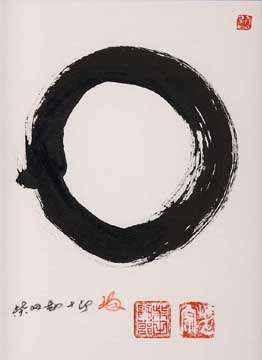Ensō
In Zen, ensō (円相, "circular form")[1] is a circle that is hand-drawn in one or two uninhibited brushstrokes to express a moment when the mind is free to let the body create.

Description
The ensō symbolizes absolute enlightenment, strength, elegance, the universe, and mu (the void). It is characterised by a minimalism born of Japanese aesthetics.
Drawing ensō is a disciplined-creative practice of Japanese ink painting, sumi-e. The tools and mechanics of drawing the ensō are the same as those used in traditional Japanese calligraphy: One uses an ink brush to apply ink to washi (a thin Japanese paper).
The circle may be open or closed. In the former case, the circle is incomplete, allowing for movement and development as well as the perfection of all things. Zen practitioners relate the idea to wabi-sabi, the beauty of imperfection. When the circle is closed, it represents perfection, akin to Plato's perfect form, the reason why the circle was used for centuries in the construction of cosmological models (see Ptolemy).
Usually, a person draws the ensō in one fluid, expressive stroke. When drawn according to the sōsho (cursive) style of Japanese calligraphy, the brushstroke is especially swift. Once the ensō is drawn, one does not change it. It evidences the character of its creator and the context of its creation in a brief, continuous period of time. Drawing ensō is a spiritual practice that one might perform as often as once per day.[2]
This spiritual practice of drawing ensō or writing Japanese calligraphy for self-realization is called hitsuzendō. ensō exemplifies the various dimensions of the Japanese wabi-sabi perspective and aesthetic: Fukinsei (asymmetry, irregularity), kanso (simplicity), koko (basic; weathered), shizen (without pretense; natural), yugen (subtly profound grace), datsuzoku (freedom), and seijaku (tranquility). [See also Japanese aesthetics#Wabi-sabi)
Use outside of Zen Buddhism
- Enso Gallery in Malibu, California features the original zen enso style paintings of local artist Tyler L. Barnett. [3]
- Between 1995 and 2006, Lucent Technologies used a red ensō logo, designed by Landor Associates,[4] meant to convey creativity and urgency.[5]
- Philosopher Joseph Campbell's book, The Hero with a Thousand Faces, bears this symbol on its cover representing creativity and uninhibited freedom of expression within art/literature.
- The book The Lean Startup uses an enso on the cover. One of the concepts in the approach includes a learning cycle 'Build - Measure - Learn".
- The design of Apple Campus 2, Apple Inc.'s ring-shaped corporate headquarters, might also have been inspired by the ensō.[6]
- AMD uses an ensō in the marketing of its Ryzen processors with the Zen microarchitecture.
- MINDBODY prominently features an ensō in its company logo.
- HSBC bank released a card named zero using as logo an ensō.
- KOAN Sound uses an open ensō in their logo as the 'O' character.
- The Ensō bootloader vulnerability that allows the HENkaku exploit in PlayStation Vita consoles to run permanently uses an ensō as its logo.
- A mobile smartphone app for meditation is called Ensō app. [7]
See also
- Abstract expressionism, a 20th-century American art movement
- Buddhism in Japan
- Dhyāna in Buddhism, a meditation practice in which the observer detaches from several qualities of the mind
- Ink wash painting, an East Asian style of brush painting that uses black ink
- Ouroboros, an ancient symbol depicting a serpent or dragon eating its own tail
References
- Tanahashi, Kazuaki (2013). Treasury of the True Dharma Eye. Shambhala. p. 1115. ISBN 978-0-8348-2836-0.
圓相 [ensō], literally, circle form. Represents enlightenment. 團圝 [danran], literally, circle round. Represents intimacy.
- Seo, Audrey Yoshiko (2007). Ensō: Zen Circles of Enlightenment. Boston: Weatherhill. ISBN 9780834805750. OCLC 71329980.
- "Imperfectly Perfecty". Retrieved 31 July 2020.
- Bowie, James (9 May 2006). "The Lucent Logo Legacy: Long Live the Big Red Donut". American Institute of Graphic Arts. Archived from the original on 11 October 2007. Retrieved 25 November 2013.
- McGowan, John (17 March 1997). "Elucidating Lucent's "Million-dollar Coffee Stain"". CNNMoney.com. Time Warner. Archived from the original on 3 December 2013. Retrieved 27 November 2013.
- Daly, Sean (29 December 2011). "Zen-otaph: Steve Jobs and the Meaning Behind Apple's New Campus". A/N Blog. Archived from the original on 12 May 2014. Retrieved 5 May 2014.
- "The 12 Best Meditation Apps For 2020". Retrieved 31 July 2020.
Further reading
| Wikimedia Commons has media related to Ensō. |
- Seo, Audrey Yoshiko; Addiss, Stephen (1998). The Art of Twentieth-century Zen: Paintings and Calligraphy by Japanese Masters. Boston: Shambhala Publications. ISBN 9781570623585. OCLC 39108653.